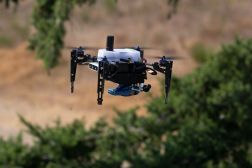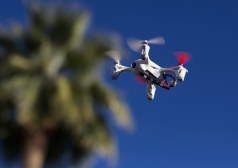Obama administration driving full speed ahead on drones
The National Science Foundation will invest $35 million over the next five years in research and development on drone design, control and application, the White House announced Tuesday.
Along with the funding commitment, the Obama administration also announced several initiatives within government and in industry that would expand drone use. Industry, academia and government leaders converged Tuesday at a workshop in Washington, D.C., to discuss the announcements and hammer out what innovations and policy are still needed to advance drone application.
“This is a huge opportunity for the U.S. to lead from a technology, from a regulatory, from a commercialization standpoint,” said Intel CEO Brian Krzanich at the workshop.
Among the announcements was an Interior Department plan to use drones to aid in search and rescue. The department has already used drones to conduct surveys and help with wildfire management, according to a White House fact sheet on the new initiatives.
And the National Oceanic and Atmospheric Administration will use an unmanned aircraft to collect more accurate gravity measurements that help with floodplain mapping and understanding coastlines, NOAA’s Unmanned Aircraft Systems Program Director Robbie Hood said at the workshop.
“It’s going to be cheaper to obtain because the fuel savings of unmanned aircraft are so significant,” Hood said.
They will also work on adding small drone capabilities to their ship fleet, Hood said.
NOAA is also looking at how to use drones to collect weather data that it can feed into forecast models in real time.
A study at NOAA is underway, Hood said, that uses both high-altitude drones and drones that can be launched from a manned aircraft.
“In both cases we’re looking at: We’re flying higher than we can with a normal aircraft, and being able to fly over storms, over the ocean and being able to look down through them and collect vertical observations,” Hood said.
Speakers at the workshop also touted the collaboration between industry and government on drones.
For example, after working with the industry to rapidly develop a registration system, the Federal Aviation Administration has registered in just eight months more than 520,000 unmanned aircraft, said FAA Administrator Michael Huerta. For perspective, only 320,000 manned aircraft are registered today.
Registration is important because it connects the drone with the operator, and gives government an opportunity to provide information on drone safety, Huerta said.
The FAA has an app that explains where it is legal and safe to fly a drone. It has already been downloaded more than 85,000 times, Huerta said.
The FAA also discussed their recently released regulations on small commercial drone use, which will take effect on Aug. 29.
“This rule is designed to allow commercial drone operations, while minimizing risk to other aircraft, as well as to people and property on the ground,” Huerta said Tuesday. “And it will provide an important regulatory foundation for allowing additional operations in the future.”
[Read more: FAA finalizes first-time rules on small commercial drones]
Right now drone operators need a waiver to fly over populated areas or beyond their line of sight. But the FAA hopes to release a rule on flying drones over people by the end of this year, Huerta said.
[Read more: Drone delivery crashes to earth under new FAA regs]
The regulations were a good first step, many industry leaders have said.
“We’re extremely happy with the FAA’s progress in this space,” Intel’s New Technology Group VP Anil Nanduri told FedScoop.
He added that industry can showcase technology that can help advance policy in areas like safety beyond the line of sight, and that “working with the policymakers actually helps us so that we can look at a problem and look at it as an objective to address together.”
Some regulations take time to work out to ensure safety, Nanduri noted, but as long as the technology can continue to be tested and piloted that is a good middle ground.






